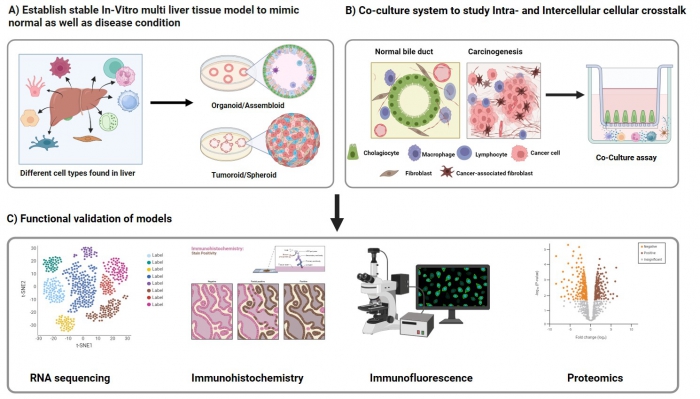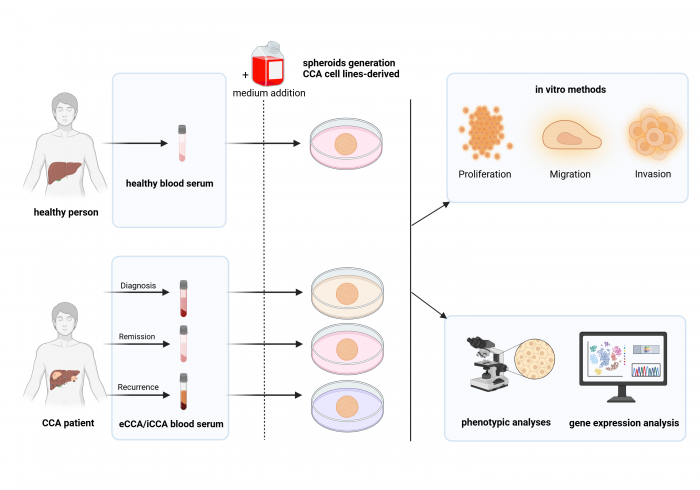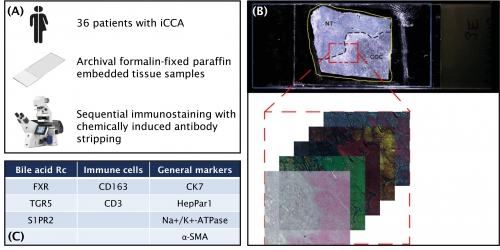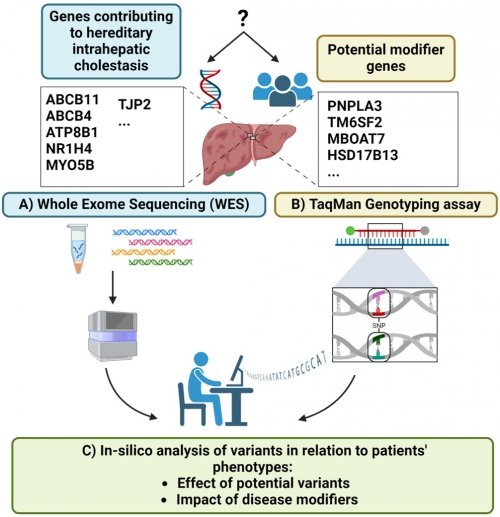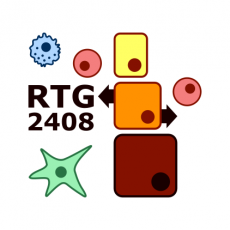Prof. Dr. Verena Keitel-Anselmino

Prof. Dr. Verena Keitel-Anselmino
Project Leader
Project 11, Project 16
P11-2: Bile acid receptors and their role for maladaptive processes in cholangiocytes and biliary diseases
Mahroo RastegariPhD Student
Verena Keitel-AnselminoProject Leader |
Biliary tract cancer, also known as cholangiocarcinoma (CCA9, accounts for about 2% of all malignancies, but incidences of intrahepatic CCA are rising and prognosis of CCA is dismal with surgical resection or liver transplantation as only curative treatment options. Chronic inflammation of the bile ducts and surrounding portal fields are a hallmark of CCA pathogenesis. Chronic diseases of the intra- and extrahepatic bile ducts, such as primary biliary cholangitis (PBC) and primary sclerosing cholangitis (PSC) predispose to CCA development. Bile acids (BAs) play a fundamental role in both liver damage and regeneration. BA effects are mediated through different receptor molecules, comprising nuclear BA receptors (BARs) and G protein-coupled receptors (GPCRs), such as the Takeda G protein-coupled receptor-5 (TGR5, GPBAR1) or the sphingosine 1-phosphate receptor-2 (S1PR2). While secondary BAs have been shown to impair epithelial barrier function in different epithelial cells through disruption of tight junction integrity, BARs such as TGR5 can protect epithelial cells at the interface with bile through increased bicarbonate secretion and phosphorylation and stabilization of tight junction and adhesional molecules.
|
Photos: by UMMD, Melitta Schubert/Sarah Kossmann
P11-3: Optimized models for studying intra- and intercellular crosstalk in biliary diseases
Shivani SinghPhD Student
Verena Keitel-AnselminoProject Leader |
Biliary diseases are characterized by complex interactions between various liver cell types, including hepatocytes, cholangiocytes, and immune cells, mediated through intricate intra- and intercellular signalling pathways. Understanding these communication networks is essential for deciphering disease mechanisms and identifying effective therapeutic targets. Traditional models often fail to capture the complexity of cellular crosstalk and the dynamic microenvironment of the biliary system, limiting their utility for understanding disease progression and testing therapies. This highlights the need for more sophisticated multicellular organoid models and patient-specific systems to enable personalized medicine. This study focuses on the development and optimization of advanced in vitro models to investigate cellular crosstalk in biliary diseases. Key approaches include:
The advanced models developed in this study will enhance our understanding of biliary disease pathophysiology and provide valuable platforms for drug screening and the development of targeted therapies. This work underscores the importance of precise and physiologically relevant models in advancing biliary disease research and lays a solid foundation for future translational studies.
Establishment of in vitro liver models using organoids, spheroids, and co-culture systems to study cellular crosstalk in normal and diseased conditions. Functional validation is performed through RNA sequencing, immunohistochemistry, immunofluorescence, and proteomics. |
Photos: by UMMD, Melitta Schubert/Sarah Kossmann
P16-3: Screening for systemic factors in biliary diseases
Nora SiegeltPhD Student
Verena Keitel-AnselminoProject Leader |
Cholangiocarcinomas (CCAs) are a group of highly lethal bile duct cancers that arise mostly in the extrahepatic region (eCCA) from the biliary epithelium. The incidence of CCA and the global mortality rate are steadily increasing. Despite advanced therapeutic approaches, the long-term prognosis is dismal with high recurrence rates. Therefore, it is essential to better understand the underlying biology of these tumors in order to define novel therapeutic targets and approaches. In this project, we are investigating the role of systemic factors on tumor behavior using CCA patient sera. The effects of blood components on the intrahepatic biliary epithelium (iCCA) and the extrahepatic biliary epithelium in eCCA will be examined using 3D spheroid models, designed to replicate malignant tumor cells. The iCCA/eCCA spheroids will be treated with serum-derived factors including proteins, cytokines, circulating nucleic acids and metabolites. Serum samples will be collected from patients at different stages of the disease, which will allow us to analyze the dynamics of various serum-derived factors in tumor progression. The effect of sera on the proliferation, migration and invasion of spheroids will be analyzed in vitro. For examination of spheroid proliferation, 3D cell viability will be investigated using an ATP Assay and a variety of proliferation markers (e.g. Ki-67, PCNA, c-Myc) by qPCR. To evaluate the impact on spheroid migration, the area of cells emerging from the spheroids will be measured using the Fiji ImageJ software. To determine the effects of sera on spheroid invasive abilities, the area occupied by spheroids within the Matrigel will be measured. Furthermore, phenotypic changes in the shape and size of the spheroids will be assessed. Transcriptomic analyses will be performed to determine changes in gene expression of iCCA and eCCA spheroids by RNAseq and where possible compared to the patients tumor sample. In addition, the biochemical environment of eCCA and iCCA will be analyzed in more detail using LC-MS/MS and the influence of circulating bile acids and expression of different bile acid receptors will be determined. By combining advanced 3D spheroid models and patient-derived blood sera as along with the application of functional assays and gene expression studies, this study aims to deepen our understanding of CCA pathogenesis and provide an approach for the development of new therapeutic strategies.
|
Photos: by UMMD, Melitta Schubert/Sarah Kossmann
CS5: Characterisation of the cellular expression pattern of bile acid receptors in intrahepatic cholangiocellular carcinoma
|
|
Cholangiocellular carcinoma (CCA) remains asymptomatic for a long time and is therefore often only diagnosed at a locally advanced or metastatic stage. The low response rates to conventional chemotherapy combined with pronounced side effects highlight the need for new therapeutic approaches in CCA. Although several risk factors have already been identified, the pathogenesis of CCA remains largely unexplained. Bile acids may play a key role in the development of CCA. Besides being involved in fat digestion and absorption, they are important signalling molecules. They exert their effects by binding to nuclear as well as membrane-bound G-protein-coupled receptors. Important receptors include the farnesoid X receptor (FXR), the Takeda G protein-coupled receptor 5 (TGR5, GPBAR1) and the sphingosine-1-phosphate receptor 2 (S1PR2). While TGR5 and S1PR2 are increasingly expressed in CCA, FXR is downregulated. It has already been shown that bile acids can induce hepatic inflammation and biliary proliferation via their specific receptors and thus indirectly contribute to the development of CCA. Interestingly, bile acid receptors can be addressed pharmacologically, making them a potential target for specific tumour therapy. In human intrahepatic CCA cells, the FXR agonist obeticholic acid, already approved for the treatment of primary biliary cholangitis, showed an antiproliferative effect on tumour cells. Nevertheless, the spatial expression pattern of the different bile acid receptors in human CCA and adjacent non-tumour tissue is unknown, especially regarding the different cell types present in the tumour such as cholangiocytes, immune cells or fibroblasts. However, this knowledge could be the cornerstone of potential new bile acid receptor-associated therapeutic strategies in CCA. In our research project, we will investigate the expression of bile acid receptors in human tissue samples of intrahepatic CCA (iCCA) and adjacent non-tumour tissue by immunostaining. A special staining technique called multiplex immunostaining will be used. This technique allows the simultaneous staining of several antigens on a single tissue section, thus enabling not only the quantification of target structures but also the investigation of their localisation and spatial relationships. By means of specific co-staining cell types can be distinguished and thus the expression of the antigens investigated can be recorded at the cellular level. Therefore, it will be possible to shed light on the tumour microenvironment of iCCA, consisting of immune cells such as macrophages and stromal cells, the so-called cancer-associated fibroblasts (CAFs), as well as adjacent non-tumour tissue, with a particular focus on the expression of bile acid receptors. A major advantage of the multiplex immunostaining protocol is the use of formalin-fixed paraffin embedded tissue samples as starting material. A large registry of CCA patients together with histopathological material is available. Therefore, the experimental results will be correlated with clinical parameters such as response to therapy or survival. A better understanding of the cellular expression pattern of bile acid receptors in iCCA is the central aim of this project. The knowledge gained will then be used to further study the role of bile acid receptors in carcinogenesis mechanistically using in vitro approaches (cell co-culture, biliary spheroids/organoids, iCCA mouse models). The overriding goal is always to apply this knowledge to the development of new therapeutic strategies.
|
Photos: by UMMD, Melitta Schubert/Sarah Kossmann
AP11: Characterization of the genotype underlying hereditary forms of intrahepatic cholestasis
Somayeh Alinaghi ArjasPhD Student
Verena Keitel-AnselminoProject Leader |
Intrahepatic cholestasis describes defective bile formation within hepatocytes and comprises a heterogeneous group of liver diseases ranging from rare inherited chronic forms of disease to more common acquired and sometimes even transient forms. The underlying molecular mechanisms comprise defects in bile acid synthesis, nuclear signaling, vesicular trafficking, canalicular transport of bile acids and bile constituents across the epithelial barrier, tight junction-mediated impaired barrier function, and maintenance of cell polarity resulting in impaired bile secretion from hepatocytes into the canalicular lumen.
Workflow for genetic analysis in hereditary intrahepatic cholestasis. Variants in genes involved in bile formation are related to hereditary intrahepatic cholestasis. Modifier variants may contribute to disease severity and progression. A) Whole exome sequencing (WES) is performed to detect potentially relevant genetic variants in the protein-coding and adjacent regions. B) TaqMan genotyping assay is used to identify risk-modifying single nucleotide polymorphisms (SNPs) that may influence disease manifestation. C) Bioinformatic analysis of WES results is carried out for alignment, annotation, and variant prioritization.
|
Photos: by UMMD, Melitta Schubert/Sarah Kossmann








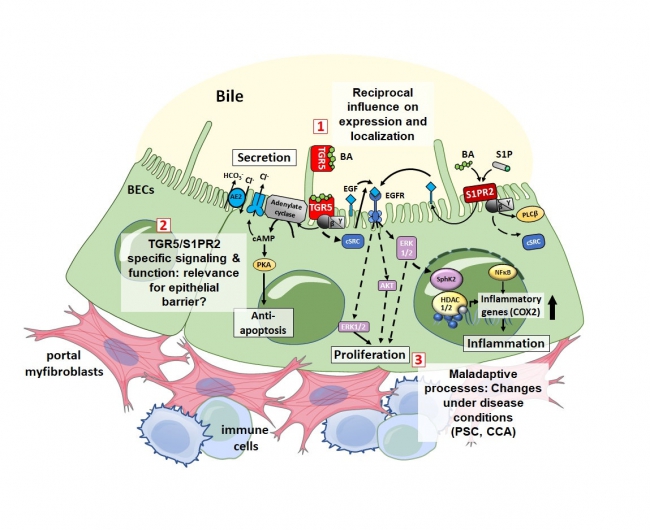 Mechanisms of interplay of TGR5 and S1PR2 for BEC barrier function under physiological and disease conditions. TGR5 and S1PR2 are both highly expressed in BECs and exert overlapping synergistic but also distinct function. Whether both receptors contribute to BEC barrier function is unknown. Furthermore, their role for maladaptive processes and inter-cellular communication (e.g. with myofibroblasts and immune cells) following biliary injury have not been elucidated.
Mechanisms of interplay of TGR5 and S1PR2 for BEC barrier function under physiological and disease conditions. TGR5 and S1PR2 are both highly expressed in BECs and exert overlapping synergistic but also distinct function. Whether both receptors contribute to BEC barrier function is unknown. Furthermore, their role for maladaptive processes and inter-cellular communication (e.g. with myofibroblasts and immune cells) following biliary injury have not been elucidated. 

